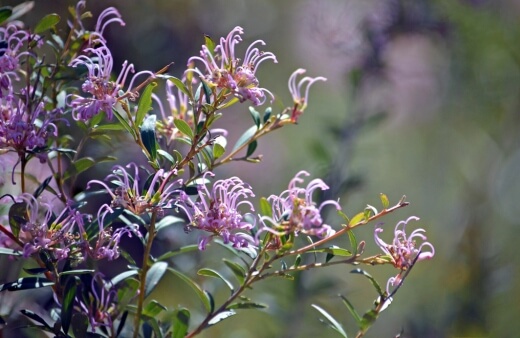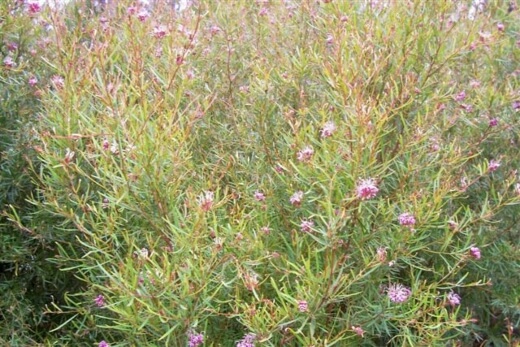I’ve covered countless grevilleas so it’s hard for me to find a species that can still surprise me but Grevillea sericea did just that.
It is prized for its perky and pink spidery flowers but that’s not all this attractive shrub has to offer. It also features light green lance-shaped leaves, luscious evergreen foliage and clusters of soft pink blooms throughout most of the year.
Read on to find out how you can grow and care for this dazzling grevillea in your garden.
More...

Source: Muchea Tree Farm
Family: | Proteaceae |
|---|---|
Genus: | Grevillea |
Species: | G. sericea |
Origin: | Australian Native |
Common Names: | Silky Grevillea, Pink Spider Flower |
Location: | Outdoor |
Type: | Shrub |
Growth: | 1 to 2 metres tall and wide |
Sun requirements: | Full sun to light shade |
Foliage Colour: | Green |
Flower Colour: | Pink |
Flowering: | Spring, Autumn, Winter |
Maintenance level: | Low |
Poisonous for pets: | Mildly toxic if consumed in large quantities |
Getting to Know Grevillea sericea
With its easy-care attitude, unmatched rosy beauty and multitude of landscaping applications, it’s no wonder this grevillea species is so well-known and widely cultivated. Enjoy massive flushes of pink flowers that can add unparalleled charm and texture to outdoor spaces.
Botanically labelled Grevillea sericea, the shrub's common names include Silky Grevillea or Pink Spider Flower. It is endemic to New South Wales where it is widespread throughout the region.
Silky grevillea prefers subtropical, warm temperate and Mediterranean climates. Cultivated in gardens, it will usually reach around 1 to 2 metres tall and wide with a fast-growing nature.
Native bees adore its nectar-rich flowers. A very popular cultivar is Grevillea sericea ‘Collaroy Plateau’.

How to Grow Grevillea sericea
Much like its relative, Grevillea lanigera, this species can also be successfully propagated by seed or by using stem cuttings. Nick seeds with a sharp knife prior to being sown to improve the chances of germination. Seeds should be sown into a quality seed-raising mix and kept in a warm and sheltered location.
If you prefer to propagate using cuttings, take firm semi-hardwood cuttings from the current season's growth that are at least 10 to 15 centimetres in length. These should strike reliably. Plant your cuttings into a quality potting mix and keep the topsoil moist.
Ideal Planting Conditions for Pink Spider Flower
This is an adaptable species that can tolerate a range of conditions. However, there are certain conditions to strive for that will allow your shrub to thrive and flower at its full potential.
Lighting Needs
For longer flowering periods and overall plant vigour, this shrub should be positioned in a sunny position. It can also be grown in lightly shaded conditions as well but full shade should be avoided.
Ideal Soil
Silky grevillea needs well-drained soils. It can tolerate different soil types but prefers sandy to loamy soils in gardens. A slightly acidic soil pH level is recommended.
Caring for Grevillea sericea
Once established, this species can tolerate light frosts and drought.
Waterings
Water regularly while young until about 12 weeks. Then, the plant requires little supplemental watering. On average, water once every 2 to 3 weeks if rainfall is insufficient.
Mulching
Mulch regularly with an organic mulch in spring and summer to maintain soil moisture and suppress weeds.
Feeding
If needed, feed with a slow-release fertiliser in spring that is low in phosphorus (3% or less).
How to Prune
Prune after flowering to maintain a compact and dense growth habit. This will also help encourage prolific flowering next season. If desired, this shrub can be left to grow on its own where it will form an attractive informal shape.

Source: Wildtech Plants
Pests and Diseases
Silky grevillea has no pest or disease issues of note.
Grevillea sericea Frequently Asked Questions
How big does Grevillea sericea get?
The pink spider flower typically reaches 1 to 2 metres tall and wide.
What is the pink spider flower called?
Botanically labelled Grevillea sericea, the shrub is also known as the Silky Grevillea and it is native to New South Wales, Australia.
Can silky grevillea grow in full shade?
Full sun to light shade is needed for this shrub to grow its best. The more shade it receives, the less vivid the flowers will be and the more the plant will struggle to grow properly.
Be sure to check out our main Grevillea post to help you choose which variety would fit your garden the most.
Perk Up Your Garden’s Potential with Grevillea Sericea
If you’re like me and admire the cheerful influence pink blooms add to gardens, then this shrub is the perfect pick for you. With its long-lasting flowering period boasting clusters of pink spidery flowers along with its easy-care attitude, there’s really little reason not to start growing the spectacular Grevillea sericea.
Published on May 27, 2023 by Nathan Schwartz
Last Updated on February 23, 2024




